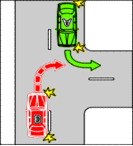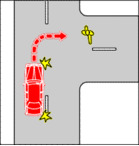 Australian Capital Territory Numbered Regulations
Australian Capital Territory Numbered Regulations Australian Capital Territory Numbered Regulations
Australian Capital Territory Numbered Regulations(1) A driver at a T-intersection without traffic lights or a stop sign, stop line, give way sign or give way line, must give way in accordance with this section.
Maximum penalty: 20 penalty units.
(2) If the driver is turning left (except if the driver is using a slip lane) or right from the terminating road into the continuing road, the driver must give way to—
(a) any vehicle travelling on the continuing road (except a vehicle making a U-turn on the continuing road at the T-intersection); and
(b) any pedestrian who is crossing the continuing road at or near the intersection.
Example 1
Driver turning right from the terminating road giving way to a vehicle on the continuing road

In this example, vehicle B must give way to vehicle A.
Example 2
Driver turning left (except if the driver is using a slip lane) from the terminating road giving way to a pedestrian on the continuing road

In this example, the vehicle must give way to the pedestrian .
(3) If the driver is turning left from the terminating road into the continuing road using a slip lane, the driver must give way to—
(a) any vehicle travelling on the continuing road (except a vehicle making a U-turn on the continuing road at the T-intersection); and
(b) any pedestrian on the slip lane.
(4) If the driver is turning left (except if the driver is using a slip lane) from the continuing road into the terminating road, the driver must give way to any pedestrian who is crossing the terminating road at or near the intersection.
Example 3
Driver turning left (except if the driver is using a slip lane) from the continuing road giving way to a pedestrian on the terminating road

In this example, the vehicle must give way to the pedestrian .
(5) If the driver is turning from the continuing road into the terminating road using a slip lane, the driver must give way to—
(a) any vehicle approaching from the right (except a vehicle making a U-turn from the terminating road at the T-intersection); and
(b) any pedestrian on the slip lane.
(6) If the driver is turning right from the continuing road into the terminating road, the driver must give way to—
(a) any oncoming vehicle that is travelling through the intersection on the continuing road or turning left at the intersection; and
(b) any pedestrian who is crossing the terminating road at or near the intersection.
(7) In this section:
turning left from the continuing road into the terminating road , for a driver, includes, where the continuing road curves to the right at a T-intersection, leaving the continuing road to proceed straight ahead onto the terminating road.
turning right from the continuing road into the terminating road , for a driver, includes, where the continuing road curves to the left at a T-intersection, leaving the continuing road to proceed straight ahead onto the terminating road.
Example 4
Driver turning right from the continuing road giving way to an oncoming vehicle travelling through the intersection on the continuing road

In this example, vehicle B must give way to vehicle A
Example 5
Driver leaving the continuing road to proceed straight ahead on the terminating road giving way to a vehicle travelling through the intersection on the continuing road

This example shows a T-intersection where the continuing road (which is marked with broken white lines) goes around a corner. Vehicle B is leaving the continuing road to enter the terminating road. In this example, vehicle B must give way to vehicle A.
Example 6
Driver turning right from the continuing road giving way to an oncoming vehicle turning left from the continuing road

In this example, vehicle B must give way to vehicle A.
Example 7
Driver turning right from the continuing road giving way to a pedestrian on the terminating road

In this example, the vehicle must give way to the pedestrian.
Division 7.3 Entering or leaving road related areas and adjacent land